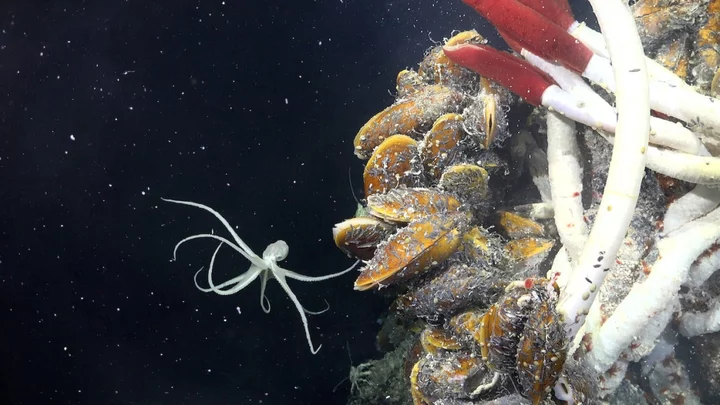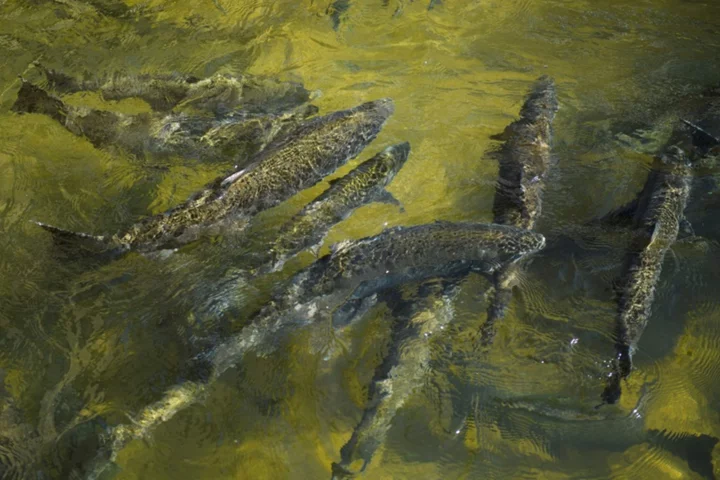The deep sea is awfully cryptic.
But scientists are making it less so.
A recent marine expedition to remote, previously unknown ocean caverns over 8,200 feet down revealed life thriving underneath hydrothermal vents — vents that emit hot, chemical-rich fluid into the water. This water, heated by the earth below, can support wild ocean ecosystems.
Ocean researchers recently embarked on this 30-day voyage to the East Pacific Rise (off of Central America) aboard the ship Falkor (too), a vessel operated by the Schmidt Ocean Institute, an organization that researches the seas. It's the first time scientists successfully peered at what might lurk beneath hydrothermal vents.
"Using an underwater robot, the science team overturned chunks of volcanic crust, discovering cave systems teeming with worms, snails, and chemosynthetic bacteria living in 75 degrees Fahrenheit (25 degrees Celsius) water," the institute said in a statement. "The discovery adds a new dimension to hydrothermal vents, showing that their habitats exist both above and below the seafloor."
SEE ALSO: Scientists discover ancient shark swimming in a really strange placeHere's a particularly interesting find: The scientists spotted creatures like tube worms "traveling underneath the seafloor through vent fluid to colonize new habitats." They're migrating through largely unknown passages.
"This truly remarkable discovery of a new ecosystem, hidden beneath another ecosystem, provides fresh evidence that life exists in incredible places," Schmidt Ocean Institute executive director Jyotika Virmani, an oceanographer, said in a statement.
The underwater robot, ROV SuBastian, used a metal bar to pull up parts of the ocean crust and reveal small caverns teeming with life. Credit: ROV SuBastian / Schmidt Ocean Institute A colony of tubeworms on a vent system over 8,200 feet beneath the surface. Credit: ROV SuBastian / Schmidt Ocean Institute Deep sea tubeworm specimens colleced by the robot ROV SuBastian and brought back to the surface for study. Credit: Monika Naranjo / Schmidt Ocean Institute Mónika Naranjo-Shepherd / Schmidt Ocean Institute A curious-looking fish, an eelpout, swims past a colony of tubeworms at a hydrothermal vent site. Credit: ROV SuBastian / Schmidt Ocean InstituteThe final image below shows an experiment — only made possible with a deep-sea robot — that proved life traveled beneath the ocean floor in this vent fluid. The robot glued mesh boxes over cracks on the seafloor, blocking entry. Days later, the robot removed the boxes. Animals, traveling through the subsurface, dwelled below.
The mesh box experiment showing life travelled beneath the ocean floor. Credit: ROV SuBastian / Schmidt Ocean InstituteDeep sea exploration missions are vital. Scientists want to shine a light — literally and figuratively — on what's down there. The implications of knowing are incalculable, particularly as deep-sea mineral prospectors prepare to run tank-like industrial equipment across parts of the seafloor. For example, research expeditions have found that ocean life carries great potential for novel medicines. "Systematic searches for new drugs have shown that marine invertebrates produce more antibiotic, anti-cancer, and anti-inflammatory substances than any group of terrestrial organisms," notes the National Oceanic and Atmospheric Administration.
"Life exists in incredible places."Want more science and tech news delivered straight to your inbox? Sign up for Mashable's Light Speed newsletter today.
Stay tuned for more deep-sea discoveries. "We always discover stuff when we go out into the deep sea. You're always finding things that you haven't seen before," Derek Sowers, an expedition lead for NOAA Ocean Exploration, told Mashable last year.









